In a critical examination of our modern dietary landscape, a recent study has shed light on the staggering presence of over 3,600 chemicals used in food packaging and preparation found within human bodies. The research, led by Birgit Geueke from the Food Packaging Forum Foundation, underscores a growing concern surrounding food safety and human health. Although about 100 of these chemicals are classified as “high concern,” the implications of many others remain largely unexplored. This gap in knowledge presents an urgent call for increased scrutiny and research into how these chemicals transition from packaging to our plates.
The researchers introduced the term Food Contact Chemicals (FCCs), which encompass the myriad substances that can “migrate” into food from various packaging materials, including plastics, paper, glass, and metals. Furthermore, exposure to these chemicals may also stem from other points in the food production chain, such as manufacturing equipment and kitchenware. This multifaceted exposure pathway complicates our understanding of how these hazardous substances infiltrate our diets.
A previous cataloging effort revealed around 14,000 unique FCCs, establishing a vast chemical landscape that can come into contact with food. The alarming discovery in this study that 3,601 of these known chemicals have been located within human samples raises vital questions about the effectiveness of current regulations and the protective measures we assume are in place.
Among the more concerning chemicals identified in the study are per- and polyfluoroalkyl substances (PFAS), referred to as “forever chemicals” due to their persistent nature in the environment and human body. Scientific studies have increasingly linked PFAS to a range of health issues, creating heightened public awareness and calls for action. Bisphenol A (BPA), another notorious compound, already faces strict regulations in many countries due to its hormone-disrupting properties, particularly concerning its impact on reproductive health. Similar concerns surround phthalates, which have also shown detrimental connections to fertility.
Interestingly, lesser-known compounds such as oligomers, byproducts of plastic-making processes, exhibited minimal scientific inquiry until now. Geueke aptly reported a significant knowledge gap regarding the health effects of these chemicals, emphasizing the need for more rigorous research to adequately assess risk.
Despite the extensive number of chemicals identified, Geueke acknowledged a key limitation in their findings: the study cannot definitively state the concentrations of the identified FCCs in human bodies. The adage “the dose makes the poison” underscores the complexity involved in evaluating these substances, suggesting that mere presence does not equate to harm. However, it is important to recognize that interactions among these chemicals could amplify their combined effects, posing an even greater risk to health. Instances of samples containing as many as 30 individual PFAS have been noted, further complicating our understanding of chemical interactions within human physiology.
Experts like Duane Mellor from the UK’s Aston University commend the comprehensive nature of this study while noting that it falls short in quantifying exposure levels. Mellor recommends that individuals remain vigilant, advocating for better transparency and data regarding the chemicals present in our environmental sphere. His message emphasizes a balanced approach—far from succumbing to unwarranted alarm, consumers should strive to minimize unnecessary exposure to potentially harmful chemicals.
Regulatory bodies are taking action as well. The European Union is poised to implement bans on the usage of PFAS in food packaging soon and has similarly proposed prohibiting bisphenol A. These legislative efforts signal a significant shift toward prioritizing public health over convenience in the packaging industry.
As society becomes more cognizant of the hidden dangers lurking in food packaging, it becomes imperative to advocate for safer practices. Consumers can safeguard themselves by reducing the contact time between food and packaging materials and avoiding heating foods in their original containers. In light of this study, it’s clear that ongoing dialogue, research, and policy reform are crucial in navigating the complex landscape of food safety and chemical exposure—an endeavor that ultimately benefits public health and wellbeing. The time for awareness and action is now, as the data reveals the profound need for change in how we approach food packaging and the safety of what we eat.

Leave a Reply